A peripheral angiogram, much like a renal angiogram, is a diagnostic imaging procedure used to identify blockages and irregularities in the blood vessels, primarily the arteries, that supply blood to the legs and feet, or the arms and hands (or groin). The term “peripheral arteries” refers to those vessels that carry blood away from the heart to the arms and legs. The procedure is conducted similarly to a renal angiogram and serves as a means to visualize abnormalities within the blood vessels; however, it is not a treatment for any underlying disease. Typically, a peripheral angiogram is recommended by physicians when there is suspicion of a significant circulatory obstruction in one or more peripheral arteries or in cases of peripheral circulation concerns
During the procedure, the physician initiates by creating a small incision in either the arms or legs, through which a rubber sheath is inserted. Following this, a thin, flexible catheter is guided into the blood vessel. To minimize discomfort, the incision area is anesthetized using a local anesthetic agent. In certain cases, especially with children, general anesthesia may be administered. Once the catheter is in place, a special dye is injected to provide visual clarity inside the artery, aiding in the detection of anomalies such as enlargement or narrowing of the peripheral arteries. This dye, containing iodine, facilitates artery visualization through X-ray imaging. Subsequently, after the completion of the procedure, the catheter and rubber sheath are carefully removed, and the incision is closed.
A peripheral angiogram typically requires more time compared to cerebral or renal angiogram procedures, lasting approximately 1-3 hours. Following the procedure, patients are usually kept in the hospital for an additional 6 hours or, in some cases, overnight. This allows healthcare professionals to monitor the incision site and vital signs such as heart rate and breathing. Upon discharge, patients are advised to consume ample fluids, primarily water, to help eliminate the contrast dye from their system. Full recovery from a peripheral angiogram may take approximately 6-8 weeks, during which patients may experience some swelling in the arms or legs. It’s important for patients to refrain from lifting heavy objects or engaging in strenuous activities until cleared by their doctor. Additionally, they should avoid prolonged periods of standing or walking briskly, as well as activities that require prolonged standing, such as cooking.
Peripheral Angiogram Treatment cost in India are as follow
| Treatment | Cost in USD | Hospital Stay |
| Peripheral Angiogram | 200 | 1-2 Days |
| Peripheral Angioplasty | 1500-2000 | 1-2 Days |
| Coronary Angioplasty | 4500-6500 | 0-1 Day |
| Coronary Angiogram | 500-700 | 0-1 Day |
| Renal Angiogram | 150 | 0-1 Day |
Frequently Asked Questions
Q:Will I need any tests before the procedure?
A:Before a Peripheral Angiogram, you may need blood tests and imaging studies to assess your health and the condition of your blood vessels.
Q:How long does the procedure take?
A: A Peripheral Angiogram typically takes about 30 minutes to 1 hour to complete.
Q:Can I eat or drink before the procedure?
A:No, typically you cannot eat or drink anything for several hours before a Peripheral Angiogram procedure.
Q:How do I choose a hospital for Peripheral Angiogram in India?
A:Kindly share your report














